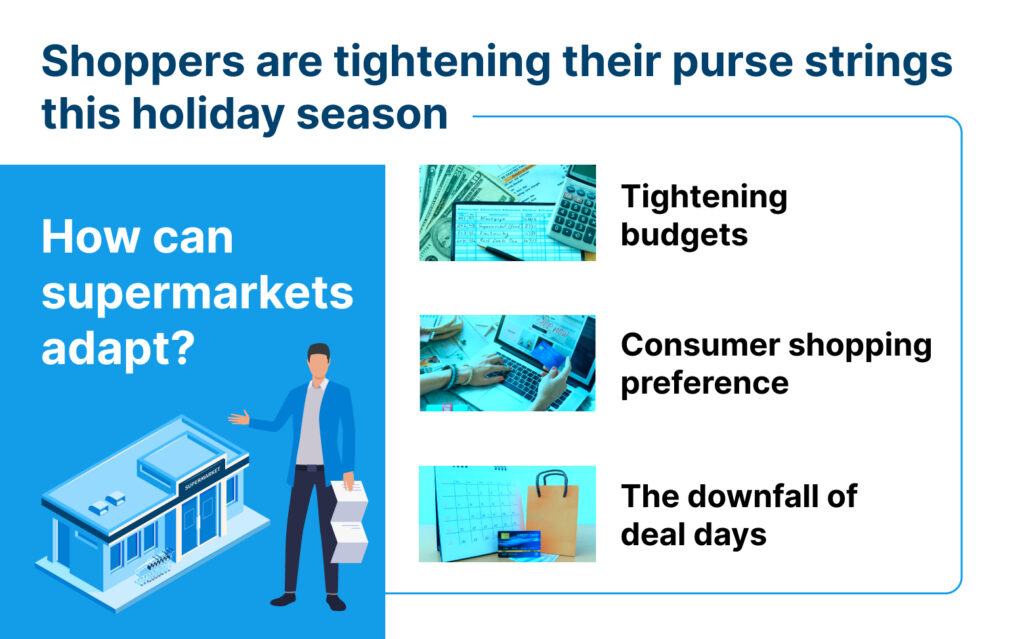
As inflation and a pending recession continue to loom over Americans’ lives, holiday shoppers are more price-sensitive than ever before. With recent data collected over the holidays, revealing that consumers are changing their shopping behaviors retailers need to start executing merchandising strategies now to brace themselves for the upcoming year or risk massive impacts to their bottom lines in the new normal. Read on for the top trends that our research uncovered about consumer behaviors/preferences around holiday shopping, how these trends will overwhelmingly have a long lasting impact on supermarket chains and how business leaders can adapt.

Tightening budgets
Based on the current economic climate, it should come as no surprise that many people are feeling a pinch this year, and our research supports this. According to the data, a majority of consumers (63%) say inflation and the looming recession have impacted the way they plan to shop for the coming holidays, and even more (74%) are tightening their budgets as a result. Additionally, in order to combat this impact and save money on gifts and other holiday goods, 49 percent plan to shop for deals and sales, and 37% plan to limit the number of people they buy gifts for.
To respond successfully to consumers tightening their holiday budgets, supermarkets will need to get creative with merchandising to set themselves apart from other brands they’re competing with. TEMPO Process Automation offers a potential solution —Vision Based Inventory Management Solution (VIMS). Our proprietary algorithm allows stores to see how their products are performing in real time. This means retailers can effectively and efficiently restock merchandise or get up-to-the-minute inventory counts during the busiest shopping time of the year, which can (in turn) alleviate cost concerns.
Consumer shopping preference
Despite the negative impacts of rising costs, consumers are returning to shopping in stores after much time away during the pandemic. Last year, 57% of consumers said they planned to make the majority of their holiday purchases online. In contrast, and while nearly all shoppers note they will primarily shop online, the majority (71%) plan to split their holiday shopping time between online and in-store.
This is a beneficial shift for retailers, and a prime opportunity to enable impulse purchases and meet consumers where they are while they are coming back to stores for holiday shopping. In order to drive purchases at high-traffic, secondary displays such as checkout lanes, stores can leverage VIMS to maintain stock based on real-time data and AI. This allows retailers to mitigate potential staffing challenges by responding to the real needs of an ever-shifting shopping climate, rather than projections based on historic data.
The downfall of deal days
According to our research, only 43% of consumers shopped on Black Friday this year — an 18% decrease from last year. Similarly, 27% plan to shopped on Cyber Monday this year, which is a staggering 40% decrease from last year. While shoppers might be coming back in-store for regular shopping, their interest in deal days appears to be dwindling.
However, it’s important to also note a recent trend — retailers increasing the number of deal days they offer. Amazon announced its Prime Early Access Sale at the end of September, Target kicked off its Black Friday sales event in early October and Walmart announced the details of its Black Friday Deals for Days event starting in November.
The impact of this uptick has yet to be fully realized, but supermarkets should still consider various types of promotional strategies to keep up with the growing competition this holiday season (and earlier).
Regardless of the methodology they use, it will be vital for brands to communicate strategically and clearly about all their promotional offers in order to anticipate and successfully meet the needs of consumers who are increasingly feeling budget-conscious this holiday season. But by observing current trends and adapting accordingly, supermarkets can approach the coming months in the new year with confidence.


